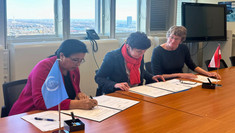Partnership between IAEA and BOKU for monitoring greenhouse gases
Greenhouse gases such as carbon dioxide and methane are major drivers of climate change and contribute to rising global temperatures and environmental instability. The IAEA (International Atomic Energy Agency), with its expertise in high-precision environmental measurements, is working with specialists at BOKU to improve research, education, and capacity building through the analysis of stable isotopes.
Stable isotopes are variants of an element that remain unchanged over time, and each stable isotope has a unique signature that scientists can use to trace its origin. Using this signature, scientists can identify specific sources of greenhouse gases, track their movement in the environment, and assess the impact of mitigation strategies.
"This partnership with the IAEA significantly improves our ability to use state-of-the-art stable isotope techniques to track and reduce greenhouse gas emissions. It strengthens BOKU's scientific research and our contribution to global climate protection through improved monitoring and capacity building," emphasizes Ursula Nopp-Mayr, Head of the Institute of Ecosystem Management, Climate and Biodiversity at BOKU.
The new agreement not only promotes a space for scientific cooperation, but also focuses on establishing a foundation to encourage countries to combat climate change with the help of nuclear science and applications.
“The significance of this partnership extends far beyond the IAEA and BOKU,” said Najat Mokhtar, Deputy Director General and Head of the IAEA's Department of Nuclear Sciences and Applications. “By sharing expertise and innovative methods, we are empowering countries to contribute more effectively to global climate protection.”
Since 2022, BOKU has been conducting stable isotope measurements using laser spectrometry at the Vienna-Arsenal radio tower to quantify greenhouse gas emissions. This work (research projects VUCL and CVCF) is being expanded and marks the next phase in the establishment of research stations in the city center and its surroundings to measure methane and carbon dioxide fluxes and concentrations.
This practical agreement grants both the IAEA and BOKU access to each other's resources, while paving the way for new opportunities and collaborations for the IAEA and national institutions.
Further information is available at
https://www.wwtf.at/funding/programmes/esr/ESR20-030/ and
https://www.wwtf.at/funding/programmes/esr/ESR24-021/

